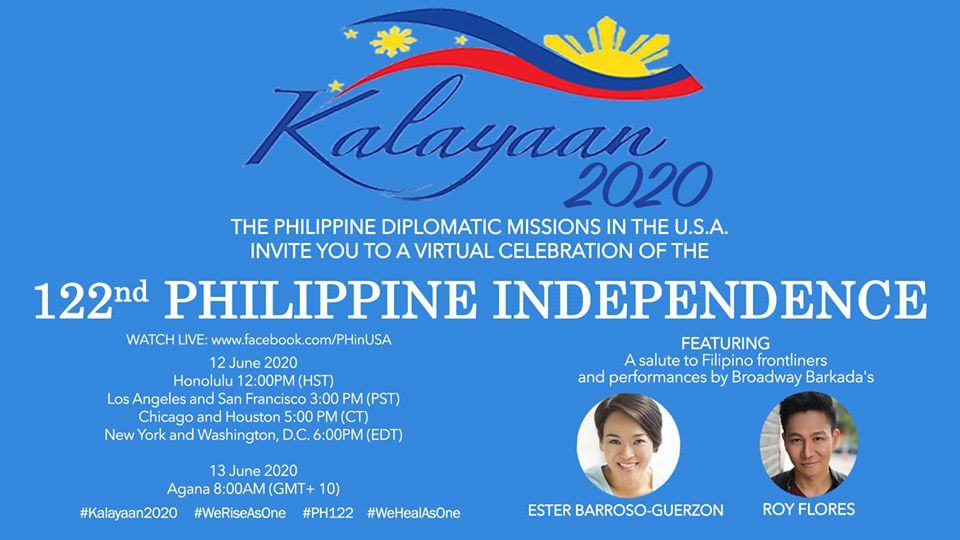FRIDAY, June 12 marks the 122nd Anniversary of the Declaration of Philippine Independence.
Instead of the annual in-person commemorations, from parades to galas in Filipino American communities across the United States, celebrations of “Araw ng Kalayaan” are going virtual this year due to the pandemic.
This year’s Independence Day celebration, bearing the theme “Kalayaan 2020: Tungo sa Bansang Malaya, Nagtutulungan, at Ligtas (Freedom 2020: Towards a Free, United, and Safe Nation), will be marked with a virtual flag-raising ceremony by all of the Philippine Diplomatic Missions in the U.S. on Friday at 3 p.m. (PST) on the Philippine Embassy in Washington’s Facebook page (facebook.com/PHinUSA).
 “As we reflect on the significance of this year’s celebration, it is equally important to recognize the various ways and opportunities by which we can rally our communities to support and uplift one another during this unprecedented time of crisis,” Philippine Ambassador to the U.S. Jose Manuel G. Romualdez said in a statement.
“As we reflect on the significance of this year’s celebration, it is equally important to recognize the various ways and opportunities by which we can rally our communities to support and uplift one another during this unprecedented time of crisis,” Philippine Ambassador to the U.S. Jose Manuel G. Romualdez said in a statement.
The occasion will also be a way to pay tribute to the Filipino and Filipino American front-liners, from doctors, nurses, medical professionals and essential workers, providing care and services amid COVID-19.
These individuals are “making tremendous sacrifices for our health and safety in the Philippines, the United States and in the Caribbean. May we draw inspiration from them as we move forward through this difficult time with the resiliency, dedication, and heart that Filipinos are known for,” the ambassador added.
Friday’s event will also feature performances by Broadway Barkada’s Ester Barroso-Guerzon and Roy Flores.
The Fil-Am community in New York, which annually mounts a parade and festival along Madison Avenue, is shifting its event online as well with virtual performances by guest artists on Friday through the Philippine Independence Day Council, Inc.’s Facebook page (facebook.com/PIDCIOfficial/Live)
In the Philippines, Independence Day is observed with a day off from work and classes. Meanwhile, the celebration across the United States traditionally takes form in parades and festivals filled with Filipino food vendors, performances, and parades.
A quick history lesson on Philippine Independence Day traces back over a century ago when the Philippines — after four centuries under Spain’s rule — declared independence on June 12, 1898.
But as many historians and Filipinos point out, June 12 didn’t mark the true liberation for the Philippines as the country in less than a year found itself under United States rule.
Upon losing the war with the U.S., Spain gave the Philippines to the U.S. as part of the 1899 Treaty of Paris Agreement. The Philippines thus became a U.S. territory with the Philippine-American War beginning a year after.
It took years for the Philippines to gain independence from the U.S. Sometime during the Philippine-American War, U.S. President Teddy Roosevelt declared victory over the Philippines ironically on the fourth of July in 1902.
After giving into the pressure of granting the Philippines independence and proclaiming amnesty between the two countries, William Howard Taft was elected as president and decided to put a halt on granting the Philippines independence.
Despite being defeated in 1912 by President Woodrow Wilson, who favored Philippine independence, plans for a sovereign Philippines weren’t made until the mid-1930s.
After one last set back due to World War II and the Japanese invasion of the Philippines, the Philippines was finally declared independent on July 4, 1946 through the Treaty of Manila.
For 15 years, the Philippines celebrated its independence annually on July 4 until 1962 when Philippine President Diosdado Macapagal officially changed the date back to June 12.
Now nearly 60 years later, Filipinos in the U.S. continue to honor Philippine Independence Day, with the younger members of today’s Fil-Am generation making their own meanings out of the holiday.






